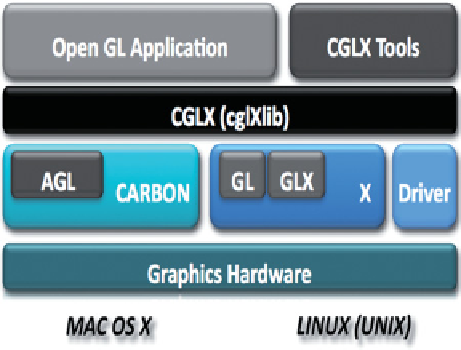Biomedical Engineering Reference
In-Depth Information
Figure 27.3
Architecture of CGLX, cross - platform, cluster - graphics middleware.
CGLX launches and manages instances of an application on all rendering
nodes through a lightweight thread-based network communication layer. A
GLUT-like (Open GL Utility Toolkit) interface is presented to the user which
allows this framework to intercept and interpret OpenGL calls and to provide
a distributed large-scale OpenGL context on a tiled display. CGLX provides
distributed parallelized rendering of OpenGL applications with all OpenGL
extensions that are supported through the graphics hardware.
27.4
VISUAL ANALYTICS APPROACH
By design, HIPerWall/HIPerSpace provides a large-scale workspace for
massive visual data correlation at great detail. More precisely, it supports the
integration of multiple imaging modalities from different biological scales
and information domains. Data size and overall system confi guration mandate
a distributed approach, which allows individual nodes to access and visualize
data while being properly synchronized via a control (head) node. The control
node also manages most user interactions as the front end into the collabora-
tive workspace. This approach takes full advantage of the computational and
graphical power of each single node while reducing network traffi c through
an out-of-core, adaptive, and progressive data access paradigm. Since the
framework was developed such that it scales fl exibly from a single node with
just one display tile to arbitrary cluster confi gurations, users may opt for using
their personal laptop side by side with the large-scale visual real estate of
the multitile system. Figure 27.4 shows a visual analytics session combining
multiple image modalities consisting of structural, functional, and brain
response data side by side with brain tractography, genetic, and archival pub-
lication data.

Search WWH ::

Custom Search